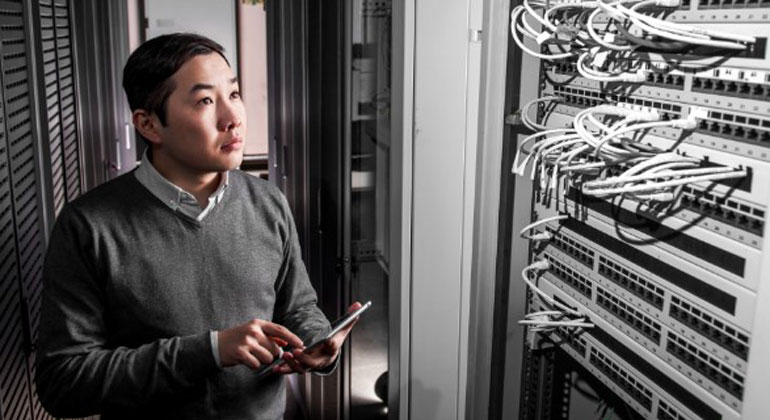New solution for reducing CO2 from data centres and server rooms
Researchers at DTU will work with industrial companies to develop a new cooling and storage system for data centres and server rooms, which will be managed through artificial intelligence and reduce energy consumption and thus CO2 emissions.
Data centres and server rooms use electricity to operate their IT equipment and cool their servers. One large data centre alone can consume electricity corresponding to up to four percent of the total Danish electricity consumption, and that figure is expected to increase significantly as our internet consumption increases and creates the need for even more data centres (source: Danish Council on Climate Change). The electricity consumed by cooling data centres and server rooms is actually expected to increase so much that it will be difficult to cover with renewable energy. In addition, the excess heat from the servers is not being used at all, which is a must if we are to increase energy efficiency.
For these reasons, researchers at DTU Compute, DTU Civil Engineering and DTU Management have joined forces with industrial companies in a project to develop a new technical and flexible energy solution that can improve energy efficiency in data centres and server rooms by up to 80 per cent.
An important element of this work is the selection and test of phase-change materials (PCMs), which are used, for example, to regulate the temperature in buildings. The researchers will develop a cold storage based on PCMs that can be used to cool the server rooms, and at the same time is using renewable energy and is integrated with the district-heating network to make use of waste heat and thereby reduce CO2 emissions in the digital sector.
The project, called ‘Cool Data,’ is a Grand Solution project supported by Innovation Fund Denmark with DKK 13 million.
“The goal is to develop a flexible thermal cooling and storage system that can store renewable energy from wind turbines and solar cells when there is a surplus of it, and use this energy in the cooling process. At the same time, the system must also be able to send the excess heat from the cooling of the servers to the district-heating network. This will create an energy system where, in future, data centres and server rooms will be fully integrated with both the electricity and district-heating systems,” says Dominik Franjo Dominkovic, a postdoc at DTU Compute and project manager for the project.
Focus on small and medium-sized data centres and server rooms
It is completely new technology that is being developed, which will be targeted at small and medium-sized data centres – that is, data centres with up to 500 servers.
“We’ve tended to focus solely on the energy consumption of large data centres here in Europe, but studies from the US show that small and medium-sized data centres make even worse use of energy. In fact, they consume between a third and half of all the energy that goes to data centres, and when you consider how many industries have server rooms, this is an important area in which to improve energy efficiency,” Dominik elaborates.
Solution to be tested in companies
The new solution requires the development of hardware in the form of the smart energy storage and cooling system. It also involves developing a smart software controller which, using artificial intelligence, will control the actual storage of energy, the cooling process and the use of waste heat, thus ensuring optimal use of energy. The integrated cooling and storage system is to be supplied with energy from various renewable energy systems.
“Once we’ve developed the software and the cooling and storage system, which we expect to be state of the art, we’ll implement the solution and test it at one of the project’s participating district-heating companies, so we know that the connection to the district-heating network works and the surplus heat is utilized there. We’re also testing the solution at an airline company,” says Dominik, who expects the test run to be completed in 2023.
The researchers will also calculate the climate and financial benefits the system will produce, as the goal is to develop the solution on a large scale. “There’s no doubt that the new flexible cooling and storage system will be able to contribute to the achievement of Denmark’s climate goals. We will therefore also analyse how much we can reduce CO2 emissions, how we can extend the solution to all industries with server rooms that need to be cooled, and where the excess heat can be utilized in the district-heating network,” says Claire Bergaentzlé, assistant professor in DTU Management, who leads the financial and climate calculations.








